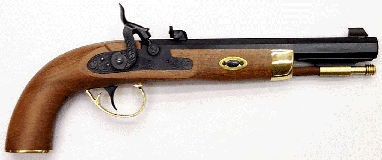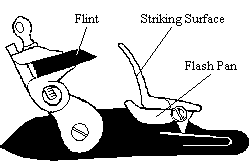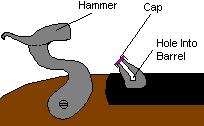The Black Powder Rifle
Muzzleloaders
The approximate timeline for the evolution of firing mechanisms is:
- Flintlock - around 1612
- Percussion Cap - 1805 and later.
Of course, there was some overlap in the time periods. Many guns were made with flintlocks first, and then adapted to percussion locks after 1805.
A flint lock muzzle loading rifle --

A percussion lock muzzle loading rifle, after 1805 --

 Mountain men depended on their long guns for basic protection and to eat. They did, however, also carry pistols as a backup in case of 'close in' fights where they needed the second shot quickly and accuracy at distance was not an issue. The pistol was usually the same caliber as their long gun so that they only had to carry one size ball. Below is an example of the type of pistol carried. Remember, the same holds true for the lock mechanism of the pistol as for the long guns. Mountain men depended on their long guns for basic protection and to eat. They did, however, also carry pistols as a backup in case of 'close in' fights where they needed the second shot quickly and accuracy at distance was not an issue. The pistol was usually the same caliber as their long gun so that they only had to carry one size ball. Below is an example of the type of pistol carried. Remember, the same holds true for the lock mechanism of the pistol as for the long guns.
What's a Lock?
The lock is the heart of the muzzleloader because, in all cases, it is the lock that provides ignition for the main powder charge in the barrel.
Virtually all muzzleloader locks are internally the same. There are variations from one type to the next, but conceptually, all work in identical fashion. The three major components of a lock are the mainspring, which may be flat, V-shaped or coil type; the tumbler, which is notched and projects through the lock plate to the hammer; and the sear, which pivots its tip into the notches of the tumbler and holds the lock in the half-cock or full-cock position.
As the hammer is drawn back, the tumbler rotates clockwise allowing the sear to ride along the bottom of the tumbler until it clicks into the first notch: the half-cock or safety notch. When the hammer is set in a secure half-cock notch, it should be IMPOSSIBLE to fire or move the hammer by pulling the trigger. If the hammer is then drawn back further, the sear will click into the second notch: the full-cock notch. The gun is now ready to be fired.
With the gun in the full-cock position, the trigger pressure will push upward on the rear portion of the sear to push the sear tip out of the full-cock notch. The tumbler will then rotate in a counter-clockwise direction under the pressure of the mainspring and drop the hammer to fire the gun.
What is the difference between a Flint lock and a Percussion lock?
The Flint Lock
 The flintlock firearm utilizes the ancient principle of flint and steel fire making. When a gun is fired, the cock, holding a flint in its jaws, swings through an arc, scraping the flint down the hardened steel face of the frizzen to produce a shower of sparks. The frizzen "kicks" forward, uncovering a small indentation, known as the flash pan, which contains FFFFg priming powder, commonly called 4F. The shower of sparks then ignites the priming powder. The "flash" of the ignited priming powder is carried through the touchhole, a small hole that connects the flash pan with the main powder charge in the barrel. The flintlock firearm utilizes the ancient principle of flint and steel fire making. When a gun is fired, the cock, holding a flint in its jaws, swings through an arc, scraping the flint down the hardened steel face of the frizzen to produce a shower of sparks. The frizzen "kicks" forward, uncovering a small indentation, known as the flash pan, which contains FFFFg priming powder, commonly called 4F. The shower of sparks then ignites the priming powder. The "flash" of the ignited priming powder is carried through the touchhole, a small hole that connects the flash pan with the main powder charge in the barrel.
This sequence takes place in a fraction of a second, when the gun has been properly loaded, primed and carries a sharp flint and a hardened frizzen.
NOTE: The spark from a flintlock falling into an unprimed pan can, at times, fire a loaded weapon. Always treat a flintlock -- primed or unprimed -- as a loaded weapon.
As you might well imagine, all that snapping, sparking and the ignition of the priming powder can be somewhat disconcerting to the beginning buckskinner, since it takes place right next to the sights through which you will be looking. This activity makes the flintlock somewhat more difficult for the beginner to master, although it adds to the challenge of the old style of ignition.
The Percussion Lock
 The Percussion Cap ignition system was developed in 1805 by the Reverend John Forsyth of Aberdeenshire. This firing mechanism is a great step in advancement from its predecessors because it does not use an exposed flash pan to begin the ignition process. Instead, it has a simple tube which leads straight into the gun barrel. The Percussion Cap ignition system was developed in 1805 by the Reverend John Forsyth of Aberdeenshire. This firing mechanism is a great step in advancement from its predecessors because it does not use an exposed flash pan to begin the ignition process. Instead, it has a simple tube which leads straight into the gun barrel.
The key to this system is the explosive cap, which is placed on top of the tube. The cap contains fulminate of mercury, a chemical compound that explodes when it is struck. This same stuff is used in the paper or plastic caps in a child's cap gun.
As illustrated above, when the hammer strikes the cap, the flames from the exploding fulminate of mercury go down the tube, into the gun barrel, and ignite the powder inside the barrel to propel the bullet.
This firing mechanism provided a major advance in reliability, since the cap was almost certain to explode when struck. This mechanism is almost immune to dampness, though in a rainfall one must still be cautious to avoid getting water in the gun barrel or into the ignition system while loading the weapon.
NOTE: Never let the hammer of a percussion firearm drop, unless the nipple is protected, as it will cause damage.
-- Thanks to The Coeur d'Alene Muzzleloaders |

